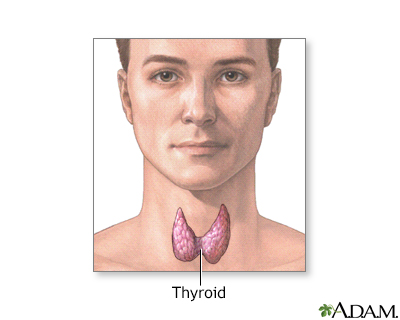Pregnancy SmartSiteTM
Toxic multinodular goiter; Plummer disease; Thyrotoxicosis - nodular goiter; Overactive thyroid - toxic nodular goiter; Hyperthyroidism - toxic nodular goiter; Toxic multinodular goiter; MNG DefinitionToxic nodular goiter involves an enlarged thyroid gland. The gland contains areas that have increased in size and formed nodules. One or more of these nodules produce too much thyroid hormone. CausesToxic nodular goiter starts from an existing simple goiter. It occurs most often in older adults. Risk factors include being female and over 55 years old. This disorder is rare in children. Most people who develop it have had a goiter with nodules for many years. Sometimes the thyroid gland is only slightly enlarged, and the goiter was not already diagnosed. Sometimes, people with toxic multinodular goiter will develop high thyroid hormone levels for the first time after:
SymptomsSymptoms may include any of the following:
Older adults may have symptoms that are less specific. These may include:
Toxic nodular goiter does not cause the bulging eyes that can occur with Graves disease. Graves disease is an autoimmune disorder that leads to an overactive thyroid gland (hyperthyroidism). Exams and TestsA physical exam may show one or many nodules in the thyroid. The thyroid is often enlarged. There may be a rapid heart rate or shaking hands (tremor). Other tests that may be done include:
TreatmentBeta-blockers can control some of the symptoms of hyperthyroidism until thyroid hormone levels in the body are under control. Certain medicines can block or change how the thyroid gland uses iodine. These may be used to control the overactive thyroid gland in any of the following cases:
Radioiodine therapy may be used. Radioactive iodine is given by mouth. It concentrates in the overactive thyroid tissue and causes damage. In rare cases, thyroid replacement is needed afterward. Surgery to remove the thyroid may be done when:
Outlook (Prognosis)Toxic nodular goiter is mainly a disease of older adults. So, other chronic health problems may affect the outcome of this condition. An older adult may be less able to tolerate the effect of the disease on the heart. However, the condition is often treatable with medicines. Possible ComplicationsHeart complications:
Other complications:
Thyroid crisis or storm is a sudden worsening of hyperthyroidism symptoms. It may occur with infection or stress. Thyroid crisis may cause:
People with this condition need to go to the hospital right away. Complications of having a very large goiter may include difficulty breathing or swallowing. This is due to pressure on the airway passage (trachea) or esophagus, which lies behind the thyroid. When to Contact a Medical ProfessionalContact your health care provider if you have symptoms of this disorder listed above. Follow your provider's instructions for follow-up visits. PreventionTo prevent toxic nodular goiter, treat hyperthyroidism and simple goiter as your provider suggests. ReferencesFiletti S, Tuttle RM, Leboulleux S, Alexander EK. Nontoxic diffuse goiter, nodular thyroid disorders, and thyroid malignancies. In: Melmed S, Auchus RJ, Goldfine AB, Koenig RJ, Rosen CJ, eds. Williams Textbook of Endocrinology. 14th ed. Philadelphia, PA: Elsevier; 2020:chap 14. Paschke R, Eszlinger M, Kopp P. Euthyroid and hyperthyroid nodules and goiter. In: Robertson RP, ed. DeGroot's Endocrinology. 8th ed. Philadelphia, PA: Elsevier; 2023:chap 77. Pearce EN, Hollenberg AN. Thyroid. In: Goldman L, Cooney KA, eds. Goldman-Cecil Medicine. 27th ed. Philadelphia, PA: Elsevier; 2024:chap 207. Suh I, Sosa JA. Thyroid. In: Townsend CM Jr, Beauchamp RD, Evers BM, Mattox KL, eds. Sabiston Textbook of Surgery. 21st ed. St Louis, MO: Elsevier; 2022:chap 37. | ||
| ||
Review Date: 2/28/2024 Reviewed By: Sandeep K. Dhaliwal, MD, board-certified in Diabetes, Endocrinology, and Metabolism, Springfield, VA. Also reviewed by David C. Dugdale, MD, Medical Director, Brenda Conaway, Editorial Director, and the A.D.A.M. Editorial team. View References The information provided herein should not be used during any medical emergency or for the diagnosis or treatment of any medical condition. A licensed medical professional should be consulted for diagnosis and treatment of any and all medical conditions. Links to other sites are provided for information only -- they do not constitute endorsements of those other sites. No warranty of any kind, either expressed or implied, is made as to the accuracy, reliability, timeliness, or correctness of any translations made by a third-party service of the information provided herein into any other language. © 1997- A.D.A.M., a business unit of Ebix, Inc. Any duplication or distribution of the information contained herein is strictly prohibited. | ||


 Thyroid enlargemen...
Thyroid enlargemen... Thyroid gland
Thyroid gland
